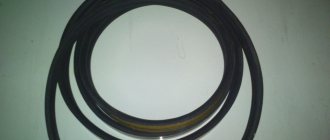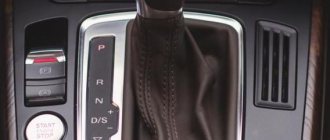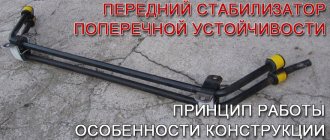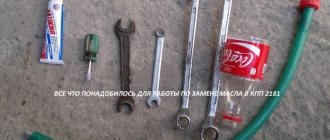When AvtoVAZ decided to install modernized transmission units on its progressive Lada Granta and Kalina models, most car enthusiasts looked at these products of the domestic automobile industry in a new way.
The updated transmission, a cable-driven gearbox, has gotten rid of the vibration that previously occurred during driving. At the heart of the design of the switching unit, instead of the previously familiar rods with the scenes, there are now connecting cables. This made it possible to eliminate the negative impact on the vibration stability of the unit.
Operational and design features
Among the main innovations of such a development as a cable-driven gearbox is a reduction in the volume of oil used in the box. Previously, the manufacturer assumed the use of mineral fluid in a volume of 3 liters, but now the unit requires semi-synthetic fluid with the amount reduced to 2.2 liters.
Many Lada Granta owners are concerned about the question that has arisen: what type of oil should they choose when replacing a progressive gearbox to ensure its normal functionality? The manufacturer continually recommends using fluids with a viscosity parameter of “75W-85” in accordance with the “GL-4” specification.
A distinctive feature of the new cable-driven gearbox from its ancestor (VAZ-2108) is the modernized switching circuit. This confirms the fact that the fifth speed is not located to the left of the first stage, but opposite the 5th gear. This design has managed to acquire serious popularity among Grant owners. It also allows you to eliminate the moment of accidental engagement of reverse gear when moving forward.
Also among the advantages of the new transmission of the Lada Grant are the following points:
- the ability to operate in severe frost (down to minus 42 degrees) while ensuring free manipulation of the lever;
- availability of the procedure for removing the switching unit without completely dismantling the transmission unit;
- quick gear changes with a minimum of effort;
- increased reliability and protection of 1st and 2nd gears due to the use of cone synchronizers;
- the fact that the intermediate segments of the synchronizers were coated with a special composition, which made it possible to improve the quality performance of the unit.
The use of a set of improvements allowed the new cable box to get rid of some previously pressing problems and acquire the ability to function stably in any conditions and modes.
The reliability and enviable functionality of the box was ensured as a result of the designers using a progressive approach to building the unit, based on computer modeling. The maximum loads exerted on the vulnerable components of the unit were correctly determined, which made it possible to improve their design and provide them with sufficient strength.
Dismantling the secondary shaft of the VAZ 2170 Priora gearbox.
After disassembling the gearbox, we proceed to disassembling the secondary shaft. For gearboxes that have been installed on cars since 2010, a shaft with catalog number 21120-1701105-30 is installed.
Photo of the secondary shaft VAZ 21120-1701105-30:
The same shafts are installed on Grant and Kalina cars.
To disassemble the shaft, we fix it in a vice, and then press the bearing using two strong screwdrivers. Usually this is successful, but sometimes the bearing is seated so tightly that there is a risk of breaking the screwdrivers. Then we use a suitable puller.
We remove the bearing, washers, 4th gear gear and under them the hub with the 3-4th gear clutch, which is secured with a retaining ring. Remove retaining ring 1:
Using two screwdrivers, pry off the 3rd gear gear and remove the gear together with the clutch:
Under the gear we see retaining ring 2 with two half rings and a ball. Let's take them off:
Now you can remove the second gear:
Remove the double-cone synchronizer 3, then remove the retaining ring of the 1st-2nd gear hub 4:
The 1st-2nd gear hub is usually easily removed, but still, in order not to pull the clutch off the hub, it is better to pry the 1st gear gear with two screwdrivers and remove the hub together with the gear.
So, the shaft has been disassembled, now you need to wash it, carefully inspect all the parts and replace it if necessary.
What should you pay attention to?
About the uniqueness of the cable unit for Granta
Replacing the rods and rockers with a cable system in the Lada Granta was intended to reduce the impact of vibration. At first, the developers were inclined to build a hydraulic circuit for the switching unit, similar to many foreign cars. Such a decision would have caused an additional increase in cost, affecting the price of the car, so the manufacturer chose a path that would take into account the financial capabilities of a wide range of buyers. The final increase in the cost of the car due to the use of a progressive cable unit reaches 5 thousand rubles. This is quite acceptable, since the price increase is insignificant, and the transmission unit is reliable.
Note that the cable gearbox has acquired more durable forks enclosed in the shift mechanism. Previously, the manufacturer used steel parts coated with bronze. Over time, abrasion of the protective layer was observed, leading to the penetration of dust into the unit with a subsequent harmful effect on the properties of the oil.
New analog forks are endowed with increased strength and have reduced weight. Aluminum is used as the material for their manufacture. An additional measure was the use of plastic linings to protect the forks from premature wear.
Also, the manufacturer of the Lada Granta mercilessly replaced the outdated lockers and springs present in the design of the switching unit. Now the main component here is the plate, which allows you to quickly “sort out” the steps. A latch moves along the surface of this element, which conveys the “intentions” of the owner to the unit (activation of the desired gear).
The cable gearbox allowed the LADA Granta gearbox to become an attribute of comfortable control of the vehicle's driving modes. Discomfort will be guaranteed to be absent due to the leveling of vibrations.
Perhaps the future promises LADA Granta the installation of a hydraulic shift mechanism, but in the present, such a solution as a cable gearbox allows you to get maximum comfort at minimal cost. The functionality of the updated box has made it possible to sufficiently get rid of annoying problems that bring frustration and discomfort to LADA Granta owners. The differential has undergone virtually no changes (with the exception of synchronizers, as already noted). This made it possible to minimize the increase in the cost of a car with such a transmission.
The cable gearbox is very simple not only to operate, but also if repairs are necessary. This is confirmed by a separately removable switching unit, a reduced volume of lubricant and its less frequent need for replacement (after 200 thousand km or a five-year interval).
AVTOVAZ’s developments do not stand still, and in 2013 the company’s management, together with the design department, decided to switch to a new type of cable-driven gearbox. These gearboxes are installed on Lada Granta and Kalina 2 cars.
Appearance of the gearbox
Lada Granta with automatic transmission
The Russian automobile industry has begun to seriously work on its mistakes, and the new Lada Granta with an automatic transmission serves as a striking example. Looking at the car body, equipment and interior, you can immediately understand that the car was manufactured by a Russian engineer for a Russian driver. The car is fully prepared for domestic roads, and almost every desire and need of the buyer is satisfied. Increased ground clearance, electric windows and a spacious trunk are ideal for the practical driver. Improved design and thoughtful shapes make the car not only practical, but also a beautiful means of transportation.
But still, the main advantage of the Lada Granta is the presence of an automatic transmission. The domestic car began to be equipped with an automatic transmission from the Japanese company Jatco. The four-speed transmission JF414E (AY-K3) from a subsidiary of Nissan is time-tested and has been serving Almera and March for a long time. Resistant to wear and aggressive driving style, the Japanese mechanism is ideal for both inexperienced beginners and experienced drivers. It is worth noting that the box has undergone minimal changes by Russian engineers, so there is no need to worry about the service life and safety of the unit. The box is time-tested, and its characteristics are not inferior to new models.
Adjusting the gearbox cable drive on the Lada Granta
Like every car mechanism, it is important to monitor the gearbox and correct any malfunction in a timely manner. In addition, you can adjust the working mechanism in order to improve the performance of the “sluggish” Lada engine. One of these upgrades is setting up a gearbox with a cable drive built into the Lada Granta. But before you tinker with a transmission element, it’s important to familiarize yourself with the consequences of tuning. It also doesn't hurt to check the warranty card. If the car's warranty has not yet expired, then it is better to hold off on setting it up, or contact a service center.
Consequences of gearbox modernization
Among the positive factors, we can note more accurate operation of the gear shift mechanism. If the setting is done correctly, vibration on the lever and extraneous noise will noticeably decrease. Fine-tuning will improve not only the accuracy of gear operation, but will also increase the reliability of the entire unit. But besides the positive properties of the gearbox modification purchased on a Lada Granta, there are also negative factors that you also need to become familiar with.
It is important to understand that any interference with the operation of well-functioning mechanisms may result in failure. As a result, you need to spend a considerable amount of money on car repairs. To independently debug a box from a domestic manufacturer, you need to have at least a little experience in car repair. If you adjust the cable on the Lada Granta machine incorrectly, the quality of switching will deteriorate significantly. Extraneous noise and vibration may appear, in the worst case, the transmission may jam. Incorrect settings will also lead to deterioration in overall technical performance.
Design and differences of a cable-driven gearbox
Unlike a conventional gearbox, the cable-driven gearbox has received some improvements and upgrades.
VAZ-2181 gearbox with cable drive
In order to understand how everything works, let’s compare a standard gearbox labeled VAZ-2180 and the new VAZ-2181:
- To reduce the vibration generated by the traction drive gearbox, cables from the manufacturer Atsumitec were installed.
- To reduce the effort for shifting 1st and 2nd gears, the manufacturer installed multi-cone synchronizers.
- The clutch size has increased to 215 mm.
- Due to changes in the transmission design, the starter had to be positioned along the engine rather than the gearbox.
- To facilitate gear shifting, it was necessary to reduce the bevel angle of the synchronizer teeth from 125 degrees to 100.
- To eliminate oil leaks, the designers moved the gear selection mechanism to the top. But this nuance gave impetus to the development of a new switching scheme and design changes.
- The volume of lubricant poured has decreased from 3.3 liters to 2.2 liters.
- A selector plate is installed, which allows you to change gears more clearly.
- The transition from mineral oil to semi-synthetic oil has been completed.
- To prevent accidental reverse gear, a special lock was developed.
Work principles
Old box with modernization
The new design is the old gearbox with significant upgrades. The previous design is known to us for its shortcomings: large lever strokes, difficult activation and low vibration comfort.
The cable driven gearbox is not a new type. The device can be safely called an updated version of the previous design, which has been made more convenient by improving it. It follows from this that the driver, accustomed to the previous version of the box, will not need to relearn. For cable gearboxes, the diameter of the clutch has been changed, increased from 200 to 215 mm. The starter was moved, installing it along the engine.
Two cables, when interacting with the box, will dampen the transmitted vibrations. This will make the shifting smoother and also reduce the travel of the gearshift knob. The cable design allows shifts to be crisp rather than harsh. In addition, the travel of the shift lever has been significantly reduced. Cable drive is superior to other design solutions in terms of seasonal changes in weather. As a result of replacing the traction drive with a cable drive, the amount of oil poured decreased by 30% due to the transfer of the gear selection mechanism to the top from the bottom.
Severe frost helps the butter thicken. A conventional gearbox requires a lot of effort to start the engine. But the cable mechanism eliminates this problem because the shift mechanism is not submerged in oil, as it is located on top.
The use of a cable drive helps to significantly reduce longitudinal movement - up to 13 cm, and transverse movement - up to 9 cm. The design is made reliable and maximally optimized. This type of gearbox is good for cars with high power engines. Since the clutch has been increased, its torque is quite high.
Box with upgrade
Shift quality and machine vibration comfort
The gearbox is a complex unit. According to many car enthusiasts, changing gears is not an easy operation. Over time, each driver gains experience in driving a car. But during the adaptation period, a huge load falls on the transmission. Drivers who lack confidence often forget to press the pedal when changing gear.
The design of the box makes it possible to have less impact on the box itself due to the reduced number of strokes. In addition, the possibility of oil leakage is eliminated. Car manufacturers believe that this box option will not affect the cost of the car.
Reviews of the updated gearbox confirm the fact that it is silent when starting the engine and when releasing the clutch. Car enthusiasts talk about easy start-up and lack of vibration. Many users agree that it is now pleasant to change gears. In reviews, some motorists point out that almost nothing has changed in the movements of the lever, but it does not dangle and clicks quietly due to the absence of play in the drive.
Interesting Facts
Let's look at the interesting facts that we managed to learn about the new Lada Granta gearbox:
- The VAZ-2181 gearbox will not be installed on the Priora, since the designers considered that it would not be cost-effective to redo the entire design of the power units.
- The cost of Lada Grant and Kalina 2 increased by 5000-7000 rubles. with the introduction of a new gearbox into the car.
- According to reviews from car owners, the first copies of cable-driven gearboxes were not entirely successful and had quite a lot of flaws: vibration became audible after 70-80 thousand mileage, howling of the gearbox, increased wear of parts, etc. Based on this, the manufacturer made adjustments to the design and improved the characteristics, but many car owners had a negative impression of the VAZ-2181 cable-driven gearbox.
- The AVTOVAZ plant continues to develop and modernize a new gearbox, which will become the second generation of cable gearboxes. It is planned to install it on the 2nd generation Lada Granta, which is currently under development. The designers promise to take into account the experience gained during the development of the first generation and not allow such an oversight a second time.
Design Features
Manual transmissions are installed on cars with both front and rear wheel drive.
Despite the development of engineering and the appearance of automatic transmissions, mechanics continue to be used and improved. The reason for this popularity is no secret. Compared to analogues, this mechanism remains the simplest to manufacture and most reliable to operate. The only drawback of manual transmissions is that in city traffic jams, the variator turned out to be more practical. In recent years, the mechanics began to be equipped with a cable drive, and this made it more convenient.
conclusions
It becomes clear that the cable-driven gearbox of the Lada Granta has become better than its younger brother with rigid rods. Modernization of components has improved performance, reduced vibration and improved gear shift quality. At the same time, many car owners still express dissatisfaction with increased wear and frequent breakdowns, although the plant promises to correct this deficiency.
Many people know that the new VAZ-2181 gearbox has a cable drive, some have heard about multi-cone synchronizers. And some claim that this is an old Renault box, which was given to AVTOVAZ engineers to be torn to pieces. The author has collected enough information to dispel myths and talk about interesting details of the new unit. Computer graphics by Dmitry Gorev.
LADA > Granta
LADA > Kalina
Gearbox functions
The gearbox is installed on cars and other self-propelled mechanisms equipped with an internal combustion engine. According to its functional purpose, it is an element of the transmission between the engine and the drive wheels. Its main task is to change the amount of torque that is transmitted from the motor to the wheels. The gearbox allows the vehicle to move in reverse and disconnect the engine from the transmission when parked. There are currently four types of transmission available:
- Mechanical;
- Automatic;
- Robotic;
- Variable speed drive.
There is another classification system for this mechanism. According to the principle of operation, a distinction is made between stepped, continuously variable and combined transmissions. According to the definition, in stepped transmissions the change in torque occurs discretely. Or stepwise. These include mechanical and robotic gearboxes. A manual gearbox, or manual transmission for short, is simply called mechanics in everyday life. In this case, we will talk specifically about mechanics, and other structures require separate consideration.
The operating principle of the car is constructed as follows. Between the engine and manual transmission there is a clutch assembly. When the driver presses the clutch pedal, the connection between the engine and the wheels is completely broken. As long as the pedal is pressed, there is nothing connecting the engine and the wheels. During this period of time, the driver engages the desired gear. The same procedure is followed when starting to move. A mechanical transmission is a metal housing containing gears and shafts.
A gear consists of two gears, usually of different diameters.
One gear is rotated by the engine, and the other transmits the rotational energy further to the wheels. When the engine rotates a wheel of smaller diameter than the one that transmits force to the wheel, the torque has high energy and low speed. If the gears have the same diameter, then neither the torque nor the speed changes during transmission. And when the engine rotates a larger gear, the speed increases and the force decreases. Gears are changed using a lever located inside the car. It is known that first gear gives the car the greatest power and the lowest speed.
REQUIREMENTS AND SUGGESTIONS
The new product, which is installed on the “Norma” and “Lux” versions, is based on the same gearbox that appeared on the VAZ-2108 and, with minor upgrades, has survived to this day. Its weaknesses are well known: difficult activation, large lever strokes, smeared switching pattern, low vibration comfort.
Figuring out what and how we could improve, we agreed on one thing: not to touch the gear part, namely the shafts, gears, and synchronizers. Otherwise, huge financial costs will be required to launch a new gearbox into production - without high-precision equipment, it will not be possible to ensure the proper quality of engagement, operation and synchronization.
So what's new in the box with the VAZ-2181 index?
Main elements of the VAZ-2181 gearbox:
Which transmission is better?
AvtoVAZ has really done a huge amount of work in order to provide motorists with a popular model with various types of transmission. Both mechanics, automatic machines, and robots have their advantages and disadvantages. The manual transmission model has become widespread partly because it is the most affordable. Despite the occasional hum and noise, a car with a 5-speed manual remains a good choice. But for residents of big cities, a car with an automatic transmission is best.
An automatic transmission with a torque converter will ensure comfortable control of the car and will not cause serious trouble. The version of the model with AMT is considered technologically advanced, modern, but at the same time the most problematic. There is a possibility that in the future the manufacturer will abandon the robot, giving preference to a CVT variator, as was done in the Lada Vesta. A sedan with a robot can be bought either new or second-hand on the secondary market. The second option is the most dangerous and unpredictable: often on manual transmissions, even before 100 thousand kilometers, the servomechanisms fail and the clutch wears out. It is extremely expensive to maintain and repair such a unit.
Lada Granta
Lada Granta
Interior of Lada Granta with automatic transmission Jatco JF414E
Interior of Lada Granta with robotic transmission
1_no_copyright
1 - main gear drive gear;
2 - secondary shaft;
3 - input shaft;
4 — fifth gear fork;
5 — fork for selecting third and fourth gears;
6 — reversing light switch;
7 — clutch housing;
8 — gear shift mechanism;
9 - central lock.
What kind of gearbox is used on Lada Granta, Kalina, Priora
Decoding of some gearbox models
:
Gearbox article
is formed from a model, part and index.
Gear ratio of the main pair
| Model | Detail | Index | Marking | ||
| 21800 | 1700012 | 00 | 01200 | 3,7 | 21120-1701105-30 |
| 10 | 80010 | 3,9 | 21120-1701105-20 | ||
| 21806 | 1700014 | 00 | Impact point method | 3,7 | 21120-1701105-30 |
| 21826 | |||||
| 21827 | 3,9 | 21120-1701105-20 |
Applicability
: This box is used on vehicles of the LADA Kalina, LADA Priora, LADA Granta families. Total volume of oil to be filled V=2.25 ±0.05l.
Impact point method
| Model | Detail | Index | Marking | Gear ratio of the main pair | Secondary shaft |
| 21810 | 1700012 | 00 | 3,7 | 2110-1701105 | |
| 77 | 4,3 | 21905-1701105-77 | |||
| 1700014 | 00 | Impact point method | 3,7 | 2110-1701105 |
Applicability
: This box is used on vehicles of the LADA Kalina, LADA Granta, LADA Granta LB family. Total volume of oil to be filled V=2.2 ±0.1l.
| Model | Detail | Index | Marking | Gear ratio of the main pair | Secondary shaft |
| 21900 | 1700012 | 00 | 2190 | 3,7 | 21120-1701105-30 |
| 01 | 2190-01 |
Applicability
: This box is used on vehicles of the LADA Granta family.
| Model | Detail | Index | Marking | Gear ratio of the main pair | Secondary shaft |
| 11180 | 1700011* | 00 | 18-00 | 3,7 | 21100-1701105 |
| 1700012 | 21100-1701105 | ||||
| 01 | 18-01 | ||||
| 20 | 18-10 | 21100-1701105 | |||
| 21 | 18-21 | 21100-1701105 | |||
| 11190 | 1700011* | 00 | 19-03 | ||
| 03 | 3,9 | ||||
| 1700012 | 00 | 19-00 | 3,7 | 21120-1701105 | |
| 01 | 19-01 | 3,9 | |||
| 03 | 19-03 | ||||
| 11190** | 12 | 19-12 | 3,7 | 21120-1701105-30 | |
| 13 | 19-13 | 3,9 | 21120-1701105-20 | ||
| 23 | 19-23 | 21120-1701105-20 |
** Clutch housing 21120-1601010
Note
: Total volume of oil filled V=3.1±0.1l.
Note
: The model 11190 gearbox has 3 starter mounting points.
Applicability
: This gearbox is used on cars of the LADA Kalina family
| Model | Detail | Index | Marking | Gear ratio of the main pair | Secondary shaft |
| 21083 | 1700012 | 13 | 13 | 3,7 | 21083-1701105-31 |
| 21100 | 00 | 2110 | 21100-1701105 | ||
| 20 | 12-20 | 21120-1701105-30 | |||
| 21120 | 00 | 12-00 | 21120-1701105-30 | ||
| 01 | 12-01 | 21120-1701105-30 | |||
| 10 | 12-10 | 21120-170105-30 | |||
| 11 | 12-11 | 21120-1701105-30 | |||
| 20 | 12-20 | 21120-1701105-30 | |||
| 21 | 12-21 | 21120-1701105 |
Applicability
: This box is used on vehicles of the LADA 2110, LADA Priora, LADA Priora Coupe family. The total volume of oil to be filled is V=3.1±0.1l.
Source
SYNCHRONIZER
So, the gear part remains the same. Almost the same: in first and second gears, we still had to install multi-cone synchronizers. Firstly, for the sake of reliability: the second stage is the most loaded, and the multi-cone will undoubtedly extend its life. Secondly, to reduce the effort when shifting gears. In addition, they plan to install the VAZ-2181 gearbox on models with more powerful engines. Therefore, a clutch with a larger diameter (215 mm) is required, which naturally has a larger moment of inertia. This is an additional argument in favor of a multi-cone synchronizer. A more powerful clutch required a different housing, because the previous one accommodated a maximum of 200 mm disc. The starter also had to be moved; now it is located not along the box, but along the engine.
The first samples were equipped with a three-cone synchronizer. But calculations have shown that double-cone, cheaper ones, can withstand the required torque with a margin (see pictures). Among other advantages, they made it possible to get rid of the problematic cone on the gears of the first and second gears, which is in contact with the synchronizer ring and requires high precision in manufacturing. The ring set now creates two friction surfaces for smooth and efficient synchronization. In addition, the German manufacturer (Ho¨rbiger) applies an additional coating to the intermediate ring, which reduces wear and ensures stable operating parameters, including the required coefficient of friction.
To make shifting easier, the bevel angle of the synchronizer teeth was reduced (from 125 to 100º) and the preload force (from 150 to 70 N). If the developers had kept the same single-cone assembly with these changes, it is possible that a crunch would have appeared when the second stage was quickly implanted (especially at low temperatures) - the so-called synchronizer breakdown. This will not happen with a multi-cone due to the larger working surface.
SWITCH MECHANISM
In the old box it is located at the bottom and bathes in an oil bath. After spending the night in the cold, the oil thickened, making it difficult to change gears for the first few kilometers. In addition, at the bottom of the box there were clamps for the rods and reverse forks, a reverse light switch, and a gear selection seal - all of these are potential sources of leakage. Sealants and other materials, of course, helped, but the problem was radically solved only by moving the mechanism upstairs.
The new mechanism is a separate module. It can be installed last and removed if necessary without disassembling the box. This is technologically advanced not only in production, but also in repair. Already at the concept stage developed by the VAZ team, a selector grill appeared in it, clearly repeating the gear shift pattern and setting the lever stroke when selecting gears. The mechanism includes a lock against accidental reverse gear, which is only accessible from neutral.
Having embodied the concept in metal and made it work correctly, the unit was sent for fine-tuning to the German company (Scha¨ffler), which has long been engaged in the engineering and production of engine, transmission and chassis parts. One of the most interesting changes proposed by foreign experts is the so-called three-dimensional central plate instead of several return springs and locks. Its spatial shape is calculated by a complex computer program, and the manufacturing equipment requires high precision. After all, the central locking ball walks along this plate, and it is this plate that sets the necessary forces when turning on and selecting speeds.
The characteristics of the mechanism were selected on the original simulation stand. The tester sits down on the seat and begins to go through the gears, while the automatic system imitates the shift pattern, forces and lever strokes implemented on a specific production car. You can also upload your own settings. Don't like an overly tight lever? A couple of taps on the keyboard and the effort is reduced. So, step by step, we selected the optimal settings for the “eighty-one”. The computer processed the data and produced parameters for constructing an accurate mathematical model, according to which those very tricky central plates were made.
ROPE DRIVE
Despite the simplicity and low price, almost all manufacturers abandoned the rod drive, like on the old box. Today, designs of several rods with complex scenes are used to dampen vibrations on the lever, or a more expensive and convenient cable drive. AVTOVAZ experimented with the latter back at Samara, purchasing parts from. But with the switching mechanism located at the bottom, the performance of such a circuit is problematic, and the price of components was scary at that time. Work on the cable-driven gearbox continued as part of other projects, but the production model could only be realized now.
Which boxes howl?
The noise problem appeared after Auto VAZ introduced a manual transmission of its own production with a cable drive. These boxes pleased us with clearer gear shifting, but disappointed us with a rather loud howl, especially in 2nd and 3rd gears. The transmission that has this problem is manual transmission 2181.
Box 2181 is an improved previous model 2180. Instead of rigid rods, it is driven by a cable drive. Thanks to the reduction in the bevel of the synchronizer teeth, the gears began to engage more clearly. In 1-2 gears, conventional synchronizers were replaced with multi-cone synchronizers. It would seem that everything should be for the better, but as an unpleasant bonus to the easy gear shifting, buyers received an unpleasant soundtrack.
The plant received a large number of complaints from car owners, so in 2014 the manufacturer modernized the transmission. As AvtoVAZ assures, the updated version has become 25% quieter, but it is still far from ideal.
4_no_copyright
The single-rod gear shift drive was replaced by a cable. The unpleasant vibrations on the lever are gone, there is less play, and shifting is clearer.
It is curious that in the clutch drive, on the contrary, they planned to abandon the cable in favor of hydraulics. Unfortunately, for economic reasons, they left the previous design, although the hydraulic drive has better characteristics. In particular, the clutch pedal works more logically and clearly with it. The advantages in the layout are also obvious: it is easier to lay tubes and hoses. But the cable for the new box had to be lengthened. These are unnecessary mechanical losses, which means additional effort on the pedals and worse information content.
What did you get?
The design of the gearbox was not only optimized and made more reliable, but also almost completely eliminated unpleasant vibrations on the lever and the car body. The backlash has become smaller and the shifts are clearer. It is worth noting that the use of a modernized gearbox on the Lada Granta and Lada Kalina 2 entailed an increase in the cost of these cars by an average of 5,000 rubles. By the way, the cable box is not installed on the Lada Priora; this car uses a 2180 manual transmission with rigid rods.
Let us remind you that according to reviews, the first copies of the modified gearbox were not entirely successful. The owners noticed a decrease in vibrations, but encountered a new problem: the box began to howl. After this, AVTOVAZ made changes to the design, but the sediment remained...
Source










